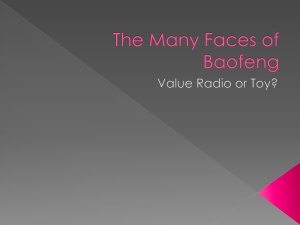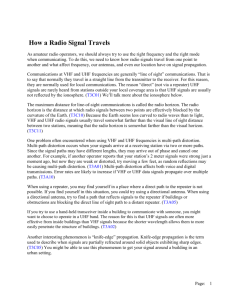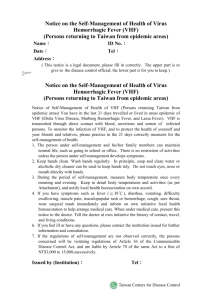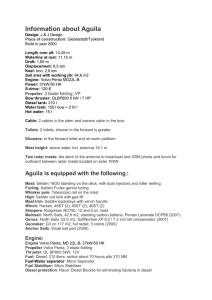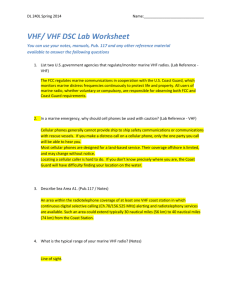MARCOM 2 - MARITIME VHF EXCHANGES
advertisement
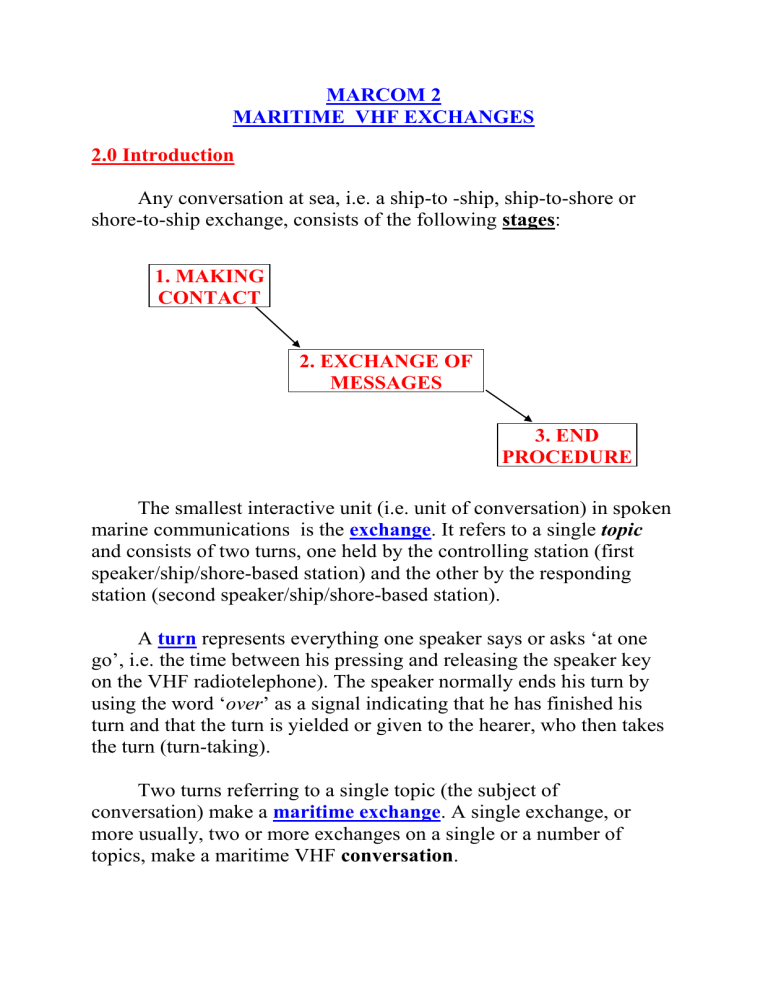
MARCOM 2 MARITIME VHF EXCHANGES 2.0 Introduction Any conversation at sea, i.e. a ship-to -ship, ship-to-shore or shore-to-ship exchange, consists of the following stages: 1. MAKING CONTACT 2. EXCHANGE OF MESSAGES 3. END PROCEDURE The smallest interactive unit (i.e. unit of conversation) in spoken marine communications is the exchange. It refers to a single topic and consists of two turns, one held by the controlling station (first speaker/ship/shore-based station) and the other by the responding station (second speaker/ship/shore-based station). A turn represents everything one speaker says or asks ‘at one go’, i.e. the time between his pressing and releasing the speaker key on the VHF radiotelephone). The speaker normally ends his turn by using the word ‘over’ as a signal indicating that he has finished his turn and that the turn is yielded or given to the hearer, who then takes the turn (turn-taking). Two turns referring to a single topic (the subject of conversation) make a maritime exchange. A single exchange, or more usually, two or more exchanges on a single or a number of topics, make a maritime VHF conversation. The most important part of the turn is the move or act, the speaker’s contribution to the exchange or success of conversation. A move or an speech act may be a word, phrase, or a sentence which the speaker uses in his turn to express his intention, query, request or purpose of communication (e.g. MAYDAY RECEIVED; WHAT ARE YOUR INTENTIONS?; WHAT ARE MY BERTHING INSTRUCTIONS?, etc.). The principal acts in maritime VHF or other spoken communications are: QUESTION ANSWER INFORMATION INSTRUCTION ADVICE REQUEST INTENTION WARNING QUESTION RECEIVED ANSWER RECEIVED INFORMATION RECEIVED INSTRUCTION RECEIVED ADVICE RECEIVED REQUEST RECEIVED INTENTION RECEIVED WARNING RECEIVED These are referred to in SMCP 2001 as MESSAGE MARKERS and introduce the speaker’s intention or what he is going to say of ask The primary acts in a normal conversation are: ACCEPT ACKNOWLEDGE AGREE ANSWER APOLOGY CALL-OFF CHECK REPLY CONFIRM DISAGREE GREETING EVALUATE EXCUSE ME INFORM INVITE REQUEST OBJECTION OFFER OPPOSE QUESTION REACT REPEAT REJECT THANK OTHER SPEECH ACTS / MOVES OR PHRASES (used in conducting maritime VHF communications are): WORD or PHRASE ACKNOWLEDGE AFFIRMATIVE ALL SHIPS IN … (AREA) BREAK CALLING CHANNEL CONFIRM CORRECTION FINAL CALL GO AHEAD HAVE A GOOD WATCH / VOYAGE HOW DO YOU READ? INTERRUPTION I SAY AGAIN I AM COMING TO YOUR ASSITANCE MAYDAY MAYDAY RELAY MESSAGE FOR YOU MISTAKE NEGATIVE NOTHING MORE … ON CHANNEL … OVER OUT PAN PAN MEANING Let me know that you have received and understood this message Yes, or permission granted I request that all ships receiving this transmission (in the specified sea area) listen to what follows I must break (into) this conversation for urgent reasons I wish to speak to … Change to channel…....... before proceeding. My version is _____. Is that correct? An error / mistake has been made in this transmission (message indicated). The correct version is ___. I have finished my operation and wish to stop communicating Proceed with your message. A polite form of ending the conversation, used before the word OUT. How well are you receiving me? Do you receive me? I READ BAD / POOR / FAIR / GOOD/WELL / EXCELLENT/1…5. I am being interrupted. I will take action to deal with it. Used instead of “I repeat”). Used as a response to an initial distress message if your ship or station is able to render assistance. The spoken word for the distress signal. Is the spoken word for the distress relay signal. In Radio Traffic: I have a message for you which I intend to read. Say if you are ready to receive it. - PASS ON YOUR MESSAGE There is a mistake in the transmission. The correct information should be … - CORRECTION: … No, or that is not correct, or I do not agree. I have finished my message I am calling on channel … My transmission is ended and I expect a response from you. I am terminating my transmission. Conversation is ended and no response is expected, The spoken word for the urgency signal. PLEASE ACKNOWLEDGE PLEASE READ BACK PLEASE SPEAK IN FULL / SLOWLY PLEASE SPELL … PLEASE USE SMCP PRUDONCE READBACK ROGER ROGER NUMBER ROGER STANDBY SAY AGAIN SECURITE SEELONCE SEELONCE DISTRESS SEELONCE FEENEE SEELONCE MAYDAY SORRY STAND BY ON VHF CHANNEL … STANDING BY on .. Indicate that you have received what I have just said Read back to me the information that I have just given READING BACK: … Do not abbreviate your messages / speak slowly, I have difficulty in following or understanding Spell (e.g. your ship's name) using the phonetic alphabet I SPELL … / I AM SPELLING … Use SMCP (formerly SMNV) during this conversation During long distress situations, communications can resume on a restricted basis. Communication is to be restricted to ship's business or messages of a higher priority. Repeat all of this message back to me exactly as received after I have given OVER. (Do not use the word "repeat".) I have received all of your last transmission. (not recommended) I have received your message number…. (not recommended) I must pause for a few seconds or minutes, please wait. (not recommended) Self-explanatory. (Do not use the word "repeat".) I SAY AGAIN : … The spoken word for the safety signal. Indicates that silence has been imposed on the frequency due to a distress situation. Is the international expression to advise that a distress situation is in progress, This command comes from a vessel or coast station other than the station in distress. Is the international expression for a distress cancellation. Is the international expression to advise that a distress situation is in progress. The command comes from the ship in distress. Polite statement of apology or for having made a MISTAKE in transmission Remain on VHF channel … STANDING BY ON CHANNEL … Response to “Stand by …” - I agree to keep watch on VHF channel … STAY ON STOP TRANSMITTING SWITCH TO VHF CHANNEL … AGREE VHF CHANNEL … SWITCHING TO CHANNEL … VHF CHANNEL … UNABLE VHF CHANNEL AVAILABLE 08 THROUGH 15 THAT IS CORRECT WHICH VHF CHANNEL? THANK YOU THIS IS … UNDERSTOOD UNKNOWN SHIP … VERIFY WAIT … MINUTES WHICH VHF CHANNEL? Do not terminate this conversation or change the subject because I have more to say Stop transmitting on this channel (a higher priority transmission going on or to be started) I suggest that you switch / go / change to channel … Positive response to the Instruction: ‘Switch to VHF channel …’ I accept the suggested channel and am just changing to / going to that VHF channel I cannot switch to channel … I can only operate on VHF channels from 8 to 15 (including ch. 8 and ch. 15) Self-explanatory Which channel do you suggest ? SWITCH TO VHF CHANNEL … Polite statement of gratitude Used to identify a station. My name (call sign) is … I have received and understood the information and I shall read it back to you now. - (optional response: READBACK IS CORRECT) I wish to make contact with the ship described. I do not know its name or call sign (give relative position, type, colour, course, speed) Check coding, check text with originator and send Correct version. Wait for … minutes and do not terminate Which channel do you suggest ? SWITCH TO VHF CHANNEL … Exercise on phrase markers (OTHER SPEECH ACTS / MOVES) (used in conducting maritime VHF communications are): Write down the VHF/SMCP phrase corresponding to the explanation in the right column: VHF/SMCP PHRASE MEANING Let me know that you have received and understood this message Yes, or permission granted I request that all ships receiving this transmission (in the specified sea area) listen to what follows I must break (into) this conversation for urgent reasons I wish to speak to … Change to channel…....... before proceeding. My version is _____. Is that correct? An error / mistake has been made in this transmission (message indicated). The correct version is ___. I have finished my operation and wish to stop communicating Proceed with your message. A polite form of ending the conversation, used before the word OUT. How well are you receiving me? Do you receive me? I READ BAD / POOR / FAIR / GOOD/WELL / EXCELLENT/1…5. I am being interrupted. I will take action to deal with it. Used instead of “I repeat”). Used as a response to an initial distress message if your ship or station is able to render assistance. The spoken word for the distress signal. Is the spoken word for the distress relay signal. In Radio Traffic: I have a message for you which I intend to read. Say if you are ready to receive it. - PASS ON YOUR MESSAGE There is a mistake in the transmission. The correct information should be … - CORRECTION: … No, or that is not correct, or I do not agree. I have finished my message I am calling on channel … My transmission is ended and I expect a response from you. I am terminating my transmission. Conversation is ended and no response is expected, The spoken word for the urgency signal. Indicate that you have received what I have just said Read back to me the information that I have just given READING BACK: … Do not abbreviate your messages / speak slowly, I have difficulty in following or understanding Spell (e.g. your ship's name) using the phonetic alphabet I SPELL … / I AM SPELLING … Use SMCP (formerly SMNV) during this conversation During long distress situations, communications can resume on a restricted basis. Communication is to be restricted to ship's business or messages of a higher priority. Repeat all of this message back to me exactly as received after I have given OVER. (Do not use the word "repeat".) I have received all of your last transmission. (not recommended) I have received your message number…. (not recommended) I must pause for a few seconds or minutes, please wait. (not recommended) Self-explanatory. (Do not use the word "repeat".) I SAY AGAIN : … The spoken word for the safety signal. Indicates that silence has been imposed on the frequency due to a distress situation. Is the international expression to advise that a distress situation is in progress, This command comes from a vessel or coast station other than the station in distress. Is the international expression for a distress cancellation. Is the international expression to advise that a distress situation is in progress. The command comes from the ship in distress. Polite statement of apology or for having made a MISTAKE in transmission Remain on VHF channel … STANDING BY ON CHANNEL … Response to “Stand by …” - I agree to keep watch on VHF channel … Do not terminate this conversation or change the subject because I have more to say Stop transmitting on this channel (a higher priority transmission going on or to be started) I suggest that you switch / go / change to channel … Positive response to the Instruction: ‘Switch to VHF channel …’ I accept the suggested channel and am just changing to / going to that VHF channel I cannot switch to channel … I can only operate on VHF channels from 8 to 15 (including ch. 8 and ch. 15) Self-explanatory Which channel do you suggest ? SWITCH TO VHF CHANNEL … Polite statement of gratitude Used to identify a station. My name (call sign) is … I have received and understood the information and I shall read it back to you now. - (optional response: READBACK IS CORRECT) I wish to make contact with the ship described. I do not know its name or call sign (give relative position, type, colour, course, speed) Check coding, check text with originator and send Correct version. Wait for … minutes and do not terminate Which channel do you suggest ? SWITCH TO VHF CHANNEL … Exercise 2.0 The following four stages in a marine VHF conversation are in the wrong order. Rewrite the stages in the correct sequence: Correct sequence of stages: AGREE A WORKING VHF 1. CHANNEL 2. EXCHANGE MESSAGES 3. TERMINATE 4. MAKE CONTACT MARCOM 2.1 – MAKING CONTACT Contact making includes the following steps: CALLING STATION 1. 2. 3. RESPONDING STATION initial call response to initial call indicating the working channel 4. agreeing/disagreeing with the working channel switch-over procedure 5. switch-over procedure Exercise 2.1 The steps of the Making Call procedure below is in the wrong sequence. Rewrite the steps in the correct order in the Table 2.1: - response to initial call indicating the working channel; agreeing/disagreeing with the working channel; initial call; switch-over procedure Table 2.1 Calling Station 1 2. 3. 4. 5. Responding Station Exercise 2.1.1 Initial call Initial call contains the following: a) Address (the station you are calling; two or three times) b) Identify (your own station) c) (state the) VHF channel (on which you are calling) d) Over. (turn-giving signal) Case 1. Single station call - name of the ship being called is known: Calling Station: RIJEKA RADIO, RIJEKA RADIO, RIJEKA RADIO THIS IS MARLIN DLG3Y, MARLIN DLG3Y. (CALLING) ON CHANNEL 16.* OVER Responding Station: MARLIN DLG3Y, MARLIN DLG3Y. THIS IS RIJEKA RADIO, RIJEKA RADIO (ON VHF CHANNEL ONE-SIX)** OVER * also COME IN, PLEASE - (frequently used; not suggested by SMCP) ** also GO AHEAD (optional) Role-play 1: Work in pairs with student A playing the role of Calling Station and student B playing the role of Responding Station: Calling Station SEA BREEZE TRG6 GENTLE OAK BRI3 DARK LADY NSCK MALINSKA HRLU GENOA PRIDE IASM9 GREAT CIRCLE PSWE NEWCASTLE CXQZ Responding Station NEWPORT PILOT STATION JEDDAH COAST STATION SANTIAGO PORT CONTROL GOTHENBURG VTS TARIFFA RADIO LLOYD’S SIGNAL STATION SAVANNAH COASTGUARD Case 2. Single station call - name and call sign of the ship/station is known: Calling station SEA BASS VC3G, SEA BASS VC3G, SEA BASS VC3G, THIS IS NEWHAVEN RADIO, NEWHAVEN RADIO, ON CHANNEL 16 OVER Responding station NEWHAVEN RADIO, NEWHAVEN RADIO THIS IS SEA BASS VC3G, SEA BASS VC3G, SEA BASS VC3G, ON CHANNEL 16 OVER Role-play 2: Work in pairs with student A playing the role of Calling Station and student B playing the role of Responding Station: Calling Station GOTHENBURG VTS JEDDAH COAST STATION BARCELONA, JKLD MADRAS II, IVCX SWORDFISH, EWQO RIJEKA RADIO JEDDAH COAST STATION Responding Station SEA BREEZE TRG6 GENTLE OAK BRI3 DARK LADY NSCK MALINSKA HRLU GENOA PRIDE IASM9 GREAT CIRCLE PSWE NEWCASTLE CXQZ Case 3 General Call - name of the station/ship is unknown: Example 1: CALLING STATION ALL SHIPS, ALL SHIPS, ALL SHIPS IN SEA AREA BAY OF RIJEKA, CALLING UNKNOWN SHIP, TYPE: TANKER, HULL COLOUR: BLUE, COURSE: 158 DEGREES, SPEED: 14 KNOTS. THIS IS RIJEKA RADIO, RIJEKA RADIO. OVER or OVER ALL STATIONS, ALL STATIONS, ALL STATIONS IN SEA AREA MAAS APPROACH, CALLING UNKNOWN SHIP IN POSITION: BEARING: 1-8-5 DEGREES FROM BOUY B15 DISTANCE: 0.6 MILES. THIS IS ROTTERDAM VTS. OVER. RESPONDING STATION: ROTTERDAM VTS. ROTTERDAM VTS. THIS IS SEA URCHIN, N-W-F-9, IN POSITION: BEARING: 1-8-5 DEGREES FROM PUNTA STELLA, DISTANCE: 4.6 MILES. OVER. or CONTAINER VESSEL ON MY PORT BOW*, CONTAINER VESSEL ON MY PORT BOW, COURSE: 172 DEGREES, SPEED: 12 KNOTS. THIS IS MOTOR TANKER SHELLFISH, MOTOR TANKER SHELLFISH ON YOUR STARBOARD BOW. OVER. * Though very frequent in real situations at sea, this type of VHF communication is discouraged by SMCP 2001 and COLREGS 1972. Instead, vessels should fully observe the Collision Regulations. Ex. 2.2 Role play 3 – pair work 1 2 3 4 5 6 7 CALLING Station RESPONDING Station NEWPORT PILOT Newport Waterway; VLCC, STATION yellow funnel; 145 degr 1.6 NM from Point Mike (SEA BREEZE TRG6) JEDDAH COAST Jeddah VTS, ro-ro ship, blue; STATION course and speed: 269 degrees T, 17 miles per hour (GENTLE OAK BRI3) SANTIAGO PORT Gulf of Santiago, cruise ship, CONTROL white, red funnels; 89 degrees from Cabo Holy Spirit, 2,5 nautical miles; (DARK LADY NSCK) GOTHENBURG VTS Gothenburg VTS, Container vessel, six miles from Mow Point, steering a course of 231°, at a speed of approximateIy 8 knots (MALINSKA HRLU) passenger ferry, white hull with TARIFFA RADIO green funnels. 6 miles from Tariffa harbour entrance, steering southwest, 10 knots (KORKYRA NIGRA HRZC) LLOYD’S SIGNAL LASH type, steering a course of STATION 50°, at a speed of 15 knots, sea area Masekar. (GREAT CIRCLE PSWE) SAVANNAH tanker: hull colour white with COASTGUARD black funnel steering 85°, at a speed of 10 knot (NEWCASTLE CXQZ) Coastal Radio Traffic Lists Example on Channel 16: ALL STATIONS, ALL STATIONS, ALL STATIONS THIS IS TOFINO COAST GUARD RADIO (repeated up to 3 times) FOR TRAFFIC LIST, LISTEN (SWITCH TO) CHANNEL 26 TOFINO COAST GUARD RADIO OUT - Define the term ‘traffic list’ - Who transmits traffic lists? - What should you (Master/OOW) do when the info on the traffic list is transmitted? 2.1.2 Responding to initial call (a) address the station, (b) identify your own station), and (c) finish your turn by saying OVER. - You can advise the calling station to proceed with the message by means of the words GO AHEAD, or, - if you are occupied, by saying STAND BY followed by the estimated number of minutes until your reply. - Do not ignore the call e.g. MARLIN DL2352. THIS IS RIJEKA RADIO GO AHEAD OVER Replying to Calls when Information Is Missing - if the identity of the calling station is uncertain: STATION CALLING SPLIT RADIO SAY AGAIN OVER 2.1.3 Switching to a Working Channel SWITCH TO (VHF CHANNEL) … Other phrases commonly used are: CHANGE TO … GO TO … Examples: Calling Station PULA, HR5432. THIS IS ALGECIRAS RADIO. SWITCH TO (VHF CHANNEL) 2 – 5 OVER Responding Station ALGECIRAS RADIO. THIS IS PULA, HR5432. AGREE VHF CHANNEL 2 - 5 OVER or ALGECIRAS RADIO. THIS IS PULA, HR5432. AGREE: SWITCHING TO VHF CHANNEL 2 - 5 OVER If the suggested channel is not available use the phrase: VHF CHANNEL … UNABLE. and then suggest another channel: VHF CHANNELS AVAILABLE: … or VHF CHANNELS AVAILABLE: … THROUGH … Example: ALGECIRAS RADIO. THIS IS PULA, HR5432. VHF CHANNEL AVAILABLE: 2 – 4. OVER or ALGECIRAS RADIO. THIS IS PULA, HR5432. VHF CHANNELS AVAILABLE: 2 – 4 THROUGH 2 - 8. OVER If the VHF channel has not been specified by the Controlling Station, the other station may ask the following: QUESTION: WHICH VHF CHANNEL? MARCOM 2.3 – AGREEING TO THE WORKING CHANNEL Exercise 2.2 Role play - Pair work CALLING STATION RESPONDING STATION 1 Rijeka Radio, suggests Ch. «Marlin» RTU5 agrees to change to 24 Ch. 24 Rijeka Radio, suggests Ch. Your VHF channel 19 is not in 19 operation. Say that you can speak on channnels from 09 to 15 Marlin RTU5 says that her Rijeka radio asks which channel is channel available is 17 available 2 Dubai Radio, suggests Ch. 18 Rostock Radio suggests Ch. 11 «Codfish» LPUJ says that her channel available is 17 «Codfish» LPUJ repeats that her channel available is 17 3 Santiago Radio, suggests Ch. 11 Perth Radio suggests Ch. 22 «Seawolf» MZGR says that her channel available is 23 «Codfish» LPUJ repeats that her channel available is 23 Perth Radio suggests Ch. 14 «Codfish» LPUJ agrees to change to Ch. 18 Your VHF channel 11 is not in oparation. Say that you can communicate on channnels from 12 to 20 Dubai radio asks which channel is available Dubai Radio agrees «Seawolf» MZGR agrees to change to Ch. 11 Your VHF channel 22 is not in oparation. Say that you can communicate on channnels from 12 to 20 Perth Radio asks which channel is available Perth Radio agrees «Seawolf» MZGR agrees to change to Ch. 14 MARCOM 2.3 – EXCHANGE MESSAGES MARCOM 2.4 – CLOSING EXCHANGES OTHER A station may say Nothing more before ending a transmission, if it has no further messages to transmit. What will it say if it does wish to pass on further messages? (NB: Model answers are printed at the end of the Exercises to Section 2.) READABILITY MESSAGE CHECKS, etc. 1.4.3 Message Checks In the course of VHF exchanges it is often necessary to check mutual understanding, i.e. if the other station follows the conversation, or when we have made a mistake during the transmission. This is done by the use of the following SMCP phrases: UNDERSTOOD: MISTAKE … CORRECTION STAY ON NOTHING MORE SAY AGAIN READ BACK - How do you read? - Wait -- -- minutes. - Please spell - Please use SMCP 2001 - Sorry - Thank you - VHF channel -- -- unable. END PROCEDURE: Closing exchanges: Thank you for your cooperation. Have a good watch. 2. Exchange of Messages In the message exchange procedure the following message markers (i.e. words introducing the content and purpose of the message) are: Message Marker QUESTION INSTRUCTION ADVICE REQUEST INFORMATION WARNING INTENTION Examples: QUESTION: What are your intentions? Answer to Message Marker ANSWER (INSTRUCTION RECEIVED) (ADVICE RECEIVED) (REQUEST RECEIVED) (INFORMATION RECEIVED) (WARNING RECEIVED) (INTENTION RECEIVED) ANSWER: I intend to alter course t o starboard WARNING: Buoy number: one five unlit ADVICE: You must anchor clear of fairway INFORMATION: The fairway entrance is: position: bearing 1-3-7 degrees true from North Point Lighthouse, distance: 2 decimal 3 miles REQUEST: Please supply bunkers: quantity: 3 thousand metric tonnes WARNING RECEIVED: Buoy number: one - five unlit ADVICE RECEIVED: I shall anchor clear of fairway INFORMATION RECEIVED: The fairway entrance is: position: bearing 1-3-7 degrees true from North Point Lighthouse, distance: 2 decimal 3 miles REQUEST RECEIVED: Supply bunkers: quantity: 3 thousand metric tonnes INSTRUCTION: Steer course two - INSTRUCTION RECEIVED: I two - three degrees true. reason: to shall steer course two - two - three comply with traffic separation degrees true to comply with traffic scheme separation scheme INTENTION: I intend to reduce INTENTION RECEIVED: You speed, new speed: eight knots intend to reduce speed, new speed: eight knots For further information on message exchanges, e.g. communications on arrival at a port, berthing and unberthing, etc. see units 18-23. 3. End Procedure In the end procedure the conversation is terminated, by confirming the previous turn: UNDERSTOOD or by saying: NOTHING MORE or GOING BACK TO CHANNEL ONE SIX or I'LL GIVE YOU A CALL BACK WHEN ON BUOY DELTA ONE TWO, and by adding a polite greeting: HAVE A GOOD WATCH HAVE PLEASANT VOYAGE TO Finally, the closing phrase OUT or OVER AND OUT is used; e.g.: CALLING STATION Seaside VTS. This is Aries. Your message understood. Nothing more. Thank you. Have a pleasant voyage to Ceuta. Over. RESPONDING STATION Aries. This is Seaside VTS. Thank you. Have a good watch. Over and out. For further information and practising maritime VHF communications see SEASPEAK 1985, SMNV 1977/1985 and SMCP 1997.
